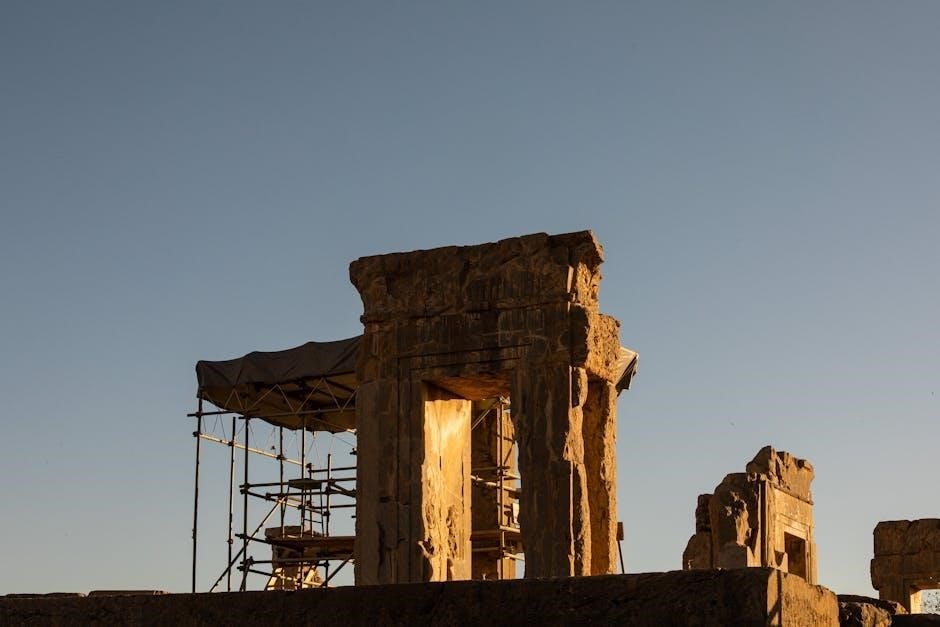The Complete Persepolis by Marjane Satrapi is a graphic memoir blending personal narrative with Iran’s modern history, offering a poignant exploration of identity, revolution, and growth.
1.1 Overview of the Graphic Novel
The Complete Persepolis is a graphic memoir by Marjane Satrapi, chronicling her childhood and adolescence during the Iranian Revolution. The novel blends personal narrative with historical context, exploring themes of identity, culture, and political upheaval. Satrapi’s journey from a sheltered life in Tehran to exile in Europe is poignant and deeply human. The graphic novel captures her struggles with cultural displacement, religious fundamentalism, and the search for self. Its black-and-white visuals and storytelling have made it a timeless work of literary art.
1.2 Importance of the Complete Edition
The complete edition of The Complete Persepolis offers a cohesive narrative, combining the original two volumes into one. This comprehensive version provides readers with a seamless exploration of Marjane Satrapi’s life, from her childhood in Iran to her experiences in Europe. The complete edition is essential for fully grasping her journey of identity, cultural displacement, and personal growth. It also underscores the historical context of the Iranian Revolution, making it a vital resource for understanding both personal and political landscapes. The unified narrative enhances the emotional and thematic depth of Satrapi’s story.

Historical Context of Persepolis and Iran
The ancient city of Persepolis, once the capital of the Achaemenid Empire, symbolizes Iran’s rich history. The Islamic Revolution of 1979 reshaped modern Iran, impacting Marjane’s life.
2.1 Ancient Persepolis and the Achaemenid Empire
Ancient Persepolis was the ceremonial capital of the Achaemenid Empire, founded by Cyrus the Great in the 6th century BCE. It symbolized Persian power and culture, with its grand palaces and intricate carvings. The empire, known for its vast territories and tolerant policies, left a lasting legacy in art, architecture, and governance. Persepolis’s ruins today stand as a testament to this golden era, reflecting the empire’s sophistication and influence.
2.2 Modern Iran and the Islamic Revolution
The Islamic Revolution of 1979 transformed Iran, overthrowing the Shah and establishing an Islamic Republic under Ayatollah Khomeini. This period marked a shift from monarchy to theocracy, with far-reaching societal changes. Strict religious laws were enforced, impacting women’s rights and freedoms. The revolution’s aftermath saw the Iran-Iraq War, economic struggles, and cultural upheaval. Marjane Satrapi’s experiences during this time highlight the personal and societal turmoil, offering a vivid portrayal of life under the new regime and its lasting impact on modern Iran.
Author Background: Marjane Satrapi
Marjane Satrapi is an Iranian-French author, filmmaker, and illustrator, best known for her graphic memoir Persepolis. Born in Rasht, Iran, her work reflects her unique cultural blend and personal experiences.
3.1 Early Life and Influences
Marjane Satrapi was born in Rasht, Iran, to a progressive family. Her parents, part of Iran’s educated elite, instilled in her a love for art and history. The Iranian Revolution and its aftermath deeply shaped her childhood, influencing her perspective on identity and culture. Satrapi’s upbringing in a politically charged environment, combined with her later experiences in Europe, formed the foundation of her storytelling. Her unique blend of Iranian heritage and Western exposure became central to her work, particularly in Persepolis.
3.2 Motivation for Writing Persepolis
Marjane Satrapi wrote Persepolis to share her personal journey of self-discovery and to challenge stereotypes about Iran. She aimed to provide an intimate perspective on the Iranian Revolution and its aftermath, offering a humanizing counter-narrative to media portrayals. By blending memoir with graphic art, Satrapi sought to connect with readers emotionally and intellectually, fostering empathy and understanding of her homeland’s complexities. Her work also reflects a desire to preserve her family’s history and cultural identity amidst political turmoil.
Key Themes in “The Complete Persepolis”
Identity, revolution, and growth are central themes in The Complete Persepolis. The graphic novel explores cultural struggles, political upheaval, and personal transformation, offering a nuanced portrayal of resilience and self-discovery amidst societal change.
4.1 Identity and Cultural Struggles
In The Complete Persepolis, Marjane Satrapi delves into the complexities of identity, particularly her own journey navigating Iranian heritage and Western influences. Her experiences of displacement, cultural dislocation, and the tension between tradition and modernity are vividly portrayed. The graphic novel highlights the challenges of reconciling multiple identities, offering a universal story of self-discovery and the quest for belonging. Through her narrative, Satrapi illustrates how cultural struggles shape personal growth and understanding of oneself in a globalized world.
4.2 Revolution and Political Upheaval
The Complete Persepolis vividly captures the turmoil of the 1979 Iranian Revolution, exploring its profound impact on individuals and society. Marjane Satrapi’s narrative weaves personal experiences with historical events, illustrating the ideological shifts and political upheaval that reshaped Iran. The graphic novel portrays the rise of religious fundamentalism, the fall of the Shah, and the ensuing repression, offering a personal lens through which to understand the broader societal transformations and their lasting effects on Iranian culture and identity.
4.3 Coming-of-Age and Personal Growth
Marjane Satrapi’s The Complete Persepolis intricately explores her journey of self-discovery and growth amidst Iran’s turbulent backdrop. The graphic novel delves into her childhood in Iran during the revolution, her adolescence in Europe, and the challenges of cultural displacement. Through her experiences, Satrapi portrays the confusion, questioning, and ultimate resilience that define her coming-of-age. The memoir captures her struggle to reconcile her Iranian heritage with her European surroundings, illustrating the universal themes of identity and personal growth. Her story resonates as a powerful tale of resilience and self-discovery.
Artistic and Narrative Techniques
Marjane Satrapi’s The Complete Persepolis masterfully blends visual storytelling with poignant narratives. Her black-and-white visuals enhance emotional depth, while symbolism and metaphors explore identity, culture, and resilience.
5.1 Visual Storytelling in the Graphic Novel
Marjane Satrapi’s The Complete Persepolis employs a powerful visual storytelling style, using black-and-white illustrations to convey deep emotions and historical context. The simplicity of her art complements the complexity of her narrative, creating a direct connection with readers. Through vivid depictions of key moments, such as the funeral of a young martyr or Marjane’s personal struggles, Satrapi transforms her memoir into a visually compelling experience. Her ability to balance simplicity with emotional depth enhances the story’s resonance and accessibility.
5.2 Use of Symbolism and Metaphor
In The Complete Persepolis, Marjane Satrapi masterfully employs symbolism and metaphor to enrich her narrative. The veil, for instance, symbolizes both oppression and cultural identity, while the character of God represents her inner dialogue and moral guidance. Metaphors like the divide between East and West illustrate her internal conflict. These elements deepen the emotional and thematic layers of her story, allowing readers to interpret and connect with her experiences on multiple levels. Satrapi’s use of such devices ensures her memoir is both personal and universally relatable.
Plot Summary and Key Events
The Complete Persepolis recounts Marjane Satrapi’s childhood in Iran during the Islamic Revolution, her exile in Europe, and her journey of identity, resilience, and self-discovery amidst upheaval.
6.1 Childhood in Iran During the Revolution
Marjane Satrapi’s childhood in Iran during the Islamic Revolution is marked by innocence and upheaval. She witnesses the Shah’s fall, the rise of Ayatollah Khomeini, and the Iran-Iraq War. Her family’s political activism and her uncle’s imprisonment shape her early understanding of freedom and oppression. The narrative captures her youthful curiosity amidst societal chaos, blending personal memories with historical context. This period lays the foundation for her identity struggles and political awakening, as she grapples with cultural and familial expectations.
6.2 Adolescence and Exile in Europe
Marjane’s adolescence unfolds in Europe, where she faces cultural displacement and loneliness. Sent abroad for safety, she navigates identity struggles, feeling disconnected from both Iranian roots and Western surroundings. Her experiences in Vienna and later Paris highlight her journey of self-discovery, marked by rebellion, heartbreak, and eventual resilience. These formative years shape her understanding of belonging and identity, blending personal growth with the challenges of exile, as she seeks to reconcile her dual heritage in a foreign environment.

Impact and Legacy of “The Complete Persepolis”
The Complete Persepolis has had a profound cultural and educational impact, earning critical acclaim and awards. It is widely used in schools to foster empathy and understanding, inspiring further exploration of graphic memoirs and their ability to bridge cultural divides.
7.1 Cultural and Literary Significance
The Complete Persepolis holds immense cultural and literary significance as a memoir that bridges East and West, offering a unique perspective on Iran’s history. Its vivid storytelling and universal themes have made it a cornerstone of contemporary literature, fostering cross-cultural understanding. By chronicling Marjane Satrapi’s personal journey, the graphic novel challenges stereotypes and provides a humanizing portrayal of life in Iran, resonating globally and earning widespread acclaim.
7.2 Adaptations and Film Versions
The Complete Persepolis has been adapted into a critically acclaimed animated film, directed by Marjane Satrapi and Vincent Paronnaud. The 2007 film captures the essence of the graphic novel, translating its visual and narrative depth into cinema. It received widespread praise, including Academy Award nominations, further cementing the book’s cultural impact. The adaptation remains faithful to the original story, preserving its emotional and historical resonance for a global audience.

Availability and Access to “The Complete Persepolis PDF”
The Complete Persepolis PDF is widely available online, offering readers digital access to Marjane Satrapi’s poignant memoir.
8.1 Digital Formats and Platforms
The Complete Persepolis PDF is accessible in various digital formats, including PDF, ePub, and Kindle, across platforms like Amazon, Google Books, and online libraries. Users can download or read it directly on devices, ensuring convenience and global accessibility. Legal access is encouraged through authorized retailers to support the author and avoid unauthorized copies, promoting ethical consumption of this influential work.
8.2 Legal and Ethical Considerations
Accessing The Complete Persepolis PDF legally is crucial to uphold copyright laws and support Marjane Satrapi’s work. Downloading from unauthorized sites violates ethical standards and deprives creators of rightful earnings. Purchasing through legitimate platforms ensures fair compensation and promotes the ethical consumption of literary works. Users are encouraged to respect intellectual property rights by avoiding pirated copies and instead acquiring the book through reputable sources.

Reader Responses and Reviews
Readers worldwide have praised The Complete Persepolis for its emotional depth and relatable themes, resonating deeply with personal journeys of identity and cultural struggles.
9.1 Critical Acclaim and Awards
The Complete Persepolis has garnered widespread critical acclaim for its profound storytelling and artistic brilliance. It won the Eisner Award and the Harvey Award, solidifying its literary and graphic excellence. Critics praise its universal themes of identity, revolution, and human resilience, resonating across cultures. The novel has been named one of the best graphic novels of all time by publications like The New York Times and Time Magazine. Its impact extends beyond literature, earning recognition for its cultural and historical significance.
9.2 Personal Reflections and Testimonials
Readers have deeply connected with The Complete Persepolis, sharing personal reflections on its emotional resonance. Many describe it as a “portal to understanding” Iran’s history and culture. The graphic novel has inspired countless testimonials, with readers praising its ability to articulate identity struggles and cultural dislocation. For many, it has been a transformative read, fostering empathy and a deeper understanding of human resilience. Personal stories highlight how the book has impacted their perspectives on identity, revolution, and personal growth, making it a cherished and impactful work in their lives.
Educational and Academic Use
The Complete Persepolis is widely used in schools and universities, offering insights into identity, culture, and history. It is valued for its ability to engage students in critical discussions about global perspectives and personal growth, making it a vital resource for educational curricula and academic research.
10.1 Use in School Curricula
The Complete Persepolis is increasingly incorporated into school curricula for its unique blend of personal narrative and historical context. Educators praise its ability to engage students in discussions about identity, cultural diversity, and global issues. The graphic novel’s visual storytelling makes complex themes accessible, fostering empathy and critical thinking. It is particularly valued in literature, history, and social studies classes, providing a relatable lens through which students can explore the Iranian Revolution and its impact on individuals. This makes it a valuable tool for fostering cross-cultural understanding and promoting inclusive education.
10.2 Academic Analysis and Research
The Complete Persepolis has become a focal point in academic research, particularly in fields like cultural studies, literary theory, and Middle Eastern history. Scholars analyze its narrative techniques, such as visual storytelling and symbolism, to explore themes of identity, exile, and political upheaval. The memoir’s autobiographical nature offers a unique perspective on the Iranian diaspora, making it a valuable resource for understanding the interplay between personal and historical narratives. Its rich textual and visual layers provide ample material for interdisciplinary studies, cementing its place in academic discourse.
Challenges and Controversies
The Complete Persepolis has faced censorship in Iran due to its critical portrayal of the regime and cultural norms. Additionally, some critics accuse Satrapi of oversimplifying complex political issues, sparking debates about representation and authenticity in storytelling.
11.1 Censorship and Bans
The Complete Persepolis has faced significant censorship, particularly in Iran, due to its portrayal of the Islamic Revolution and regime. The graphic novel’s honest depiction of political repression and social issues has led to bans in some regions. Libraries and schools worldwide have also challenged its inclusion, citing content deemed controversial or inappropriate. Despite this, its popularity endures, highlighting the power of storytelling to provoke dialogue and challenge societal norms. This censorship underscores the book’s relevance in sparking critical conversations.
11.2 Cultural and Political Criticisms
The Complete Persepolis has drawn both acclaim and criticism for its portrayal of Iranian culture and politics. Some critics argue Satrapi oversimplifies complex historical events, while others appreciate her unique perspective. The graphic novel’s depiction of the Islamic Revolution and its aftermath has sparked debates about representation and authenticity. Additionally, its exploration of identity and exile resonates deeply with many readers, balancing personal and political narratives. These critiques highlight the book’s ability to provoke thought and foster understanding of Iran’s rich yet tumultuous history.
The Complete Persepolis is a profound memoir that explores identity, revolution, and resilience, offering a deeply personal yet universally relatable journey through Iran’s turbulent history and culture.
12.1 Final Thoughts on the Graphic Novel
The Complete Persepolis is a masterpiece that transcends traditional storytelling, blending history, memoir, and art. Marjane Satrapi’s journey from childhood to adulthood, set against Iran’s turbulent backdrop, resonates deeply. The graphic novel’s raw honesty and visual simplicity captivate readers, offering insights into identity, culture, and resilience. Its exploration of universal themes like belonging and self-discovery ensures its enduring relevance. A poignant and powerful work, Persepolis remains a vital read for understanding the human condition amidst political and societal upheaval.
12.2 Encouragement for Further Reading
Engaging with The Complete Persepolis opens doors to deeper explorations of Iranian history and personal narratives. Readers are encouraged to delve into Marjane Satrapi’s other works, such as Embroideries and Chicken with Plums, for additional perspectives. Exploring historical texts on the Islamic Revolution and modern Iran can enrich understanding. Discussions with others and academic analyses offer further insight, making Persepolis a gateway to broader cultural and literary discovery.
